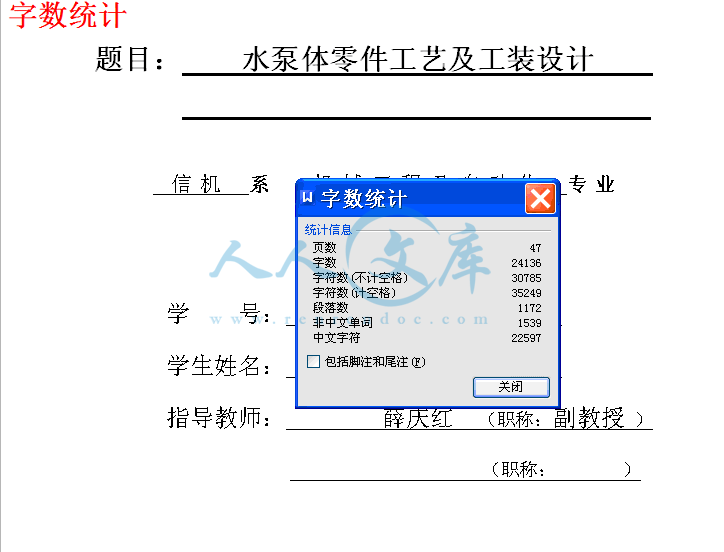摘 要
在机床上加工工件时,定位和夹紧的全过程称为“安装”。在机床上用来完成工件安装任务的重要工艺装备,就是各类夹具中应用最为广泛的“机床夹具”。
机床夹具的种类很多,其中,使用范围最广的通用夹具,规格尺寸多已标准化,并且有专业的工厂进行生产。而广泛用于批量生产,专为某工件加工工序服务的专用夹具,则需要各制造厂根据工件加工工艺自行设计制造。本设计的主要内容是设计钻床夹具,需要对泵体上表面4xM6的四个螺纹孔进行钻削。
泵体零件上往往都有各种不同用途和不同精度的孔需要加工。在机械加工中,孔的加工量所占比例较大,其中钻头、扩孔钻、铰刀、镗刀等定尺寸刀具加工占相当多数。这时,除了要保证孔的尺寸精度外,还要达到孔的位置精度要求。在单件小批量生产中,用划线后找正孔轴线位置方法加工。在批量生产中一般都采用钻床夹具与镗床夹具,钻床夹具又称钻模,镗床夹具又称镗模,通过钻套、镗套引导刀具进行加工可准确地确定刀具与工件之间的相对位置。
关键词: 通用夹具; 专用夹具; 钻床夹具; 泵体
Abstract
In the machine machining, positioning and clamping process called "installation". The machine used to complete the task of workpiece installation of process equipment, is an important fixture in the most widely used "the machine tool's fixture.
There are many kinds of the machine tool's fixture, among them, use the widest range of general fixture, size, and there has been more standardized professional factory production. And widely used in mass production, designed for a workpiece machining processes and special fixture service to the factory according to the workpiece machining process to design and manufacture. The design of the main content is boring and milling machine fixture design jigs, need to pump body surface 4xM6 of the four threaded hole for drilling.
Pump body parts are usually different purposes and accuracy of the hole machining. In machining, the hole of manufactured, among which the proportion of drilling, reaming, reamer, boring tools for size of such a sizable majority. At this time, except to ensure the accuracy of the size of the hole hole, but also achieve the position precision requirements. In single small batch production, use crossed for positive hole axis position after processing methods. In batch production in general by drilling and boring fixture, drilling fixture and diamond fixture, boring fixture and say, boring, boring set by drilling tools for processing guide can accurately determine tool and the relative position between the workpiece.
Key word: General fixture; Special jig ;Drilling fixture; Pump body
目录
摘 要III
AbstractIV
目录V
1 绪论1
1.1 课题的背景和意义1
1.2 机床夹具概述1
1.2.1 机床夹具1
1.2.2 机床夹具的功能1
1.2.3 机床夹具在机械加工中的作用2
1.2.4 机床夹具的发展趋势2
2 水泵泵体的工艺规程设计4
2.1 零件的作用4
2.2 零件图的审核4
2.2.1 分析零件图4
2.2.2 零件的结构工艺性分析5
2.3 生产过程和工艺过程5
2.3.1 生产过程5
2.3.2 工艺过程6
2.4 工艺规程7
2.5 零件的工艺分析7
2.6 选择毛坯8
2.7 坯料尺寸公差与机械加工余量的确定8
2.8 确定毛坯尺寸8
2.9 孔和平面加工分析8
2.9.1 孔和平面的加工顺序8
2.9.2 钻孔加工方案选择8
2.9.3 选择定位基准9
2.10 基面的选择10
2.11 零件表面加工方法选择10
2.12 各工序间加工余量11
2.13 制定工艺路线12
2.14 切削用量的计算13
2.14.1 铣上平面工序切削用量的计算14
2.14.2 铣下平面工序切削用量的计算14
2.14.3 铣左端面工序切削用量的计算15
2.14.4 铣右端面工序切削用量的计算15
2.14.5 钻Ø48孔工步切削用量的计算16
2.14.6 加工M10螺纹的切削用量16
2.14.7 加工M8螺纹的切削用量17
2.14.8 加工M11.3螺纹的切削用量18
2.14.9 法兰端面凸台切削用量19
2.14.10 精车轴承内孔切削用量19
2.14.11 钻Ø10孔的切削用量20
2.14.12 左端面倒角的切削用量20
2.15 机械加工时间定额的确定(参考机械加工工艺手册)20
2.15.1 机械加工时间定额的组成20
2.15.2 机械加工时间定额的计算20
2.15.3 上平面时间定额的计算21
2.15.4 下平面时间定额的计算22
2.15.5 左端面时间定额的计算23
2.15.6 右端面时间定额的计算24
2.15.7 孔Ø48的时间定额25
2.15.8 上平面螺纹孔的时间定额26
2.15.9 左端面Ø10通孔的时间定额27
2.15.10 下平面英制管螺纹的时间定额28
2.15.11 右端面螺纹孔的时间定额29
2.15.12 左端凸台铣平面的时间定额30
2.15.13 精车轴承内孔的时间定额31
2.15.14 车左端面倒角的时间定额32
3 夹具设计33
3.1 对专用夹具的基本要求33
3.2 专用夹具设计步骤33
3.3 钻螺纹孔2xM10攻螺纹夹具设计34
3.3.1 问题的提出34
3.3.2 夹具设计34
3.3.3 夹具设计及操作的简要说明36
4结论与展望37
4.1 结论37
4.2 不足之处及未来展望37
致谢38
参考文献39
1 绪论
1.1 课题的背景和意义
特殊零件工艺设计和夹具设计是一种与机械制造工艺密切相关的毕业设计课题,与实际生产有机器密切的联系,他要求我们有一定的生产实践知识。其主要目的如下:
(1)对生产知识有一定的认识,理解生产加工过程中相关机械设备的工作原理
(2)掌握机械制造相关知识,学会如何进行工艺设计及夹具设计
(3)理解和掌握夹具设计原理,能结合生产时间设计相关夹具
(4)了解夹具各原件的设计与夹具定位原理和结构
(5)理解专夹具的设计方法,学会分析夹具设计过程中的一些主要问题
(6)了解机械加工工艺过程的知识,明白它在实际中产生的意义与作用。
(7)学会如何制定加工工艺规程。
传统的手工夹具设计往往依靠设计人员的经验进行,定位方案的选取、资料的检验、分析计算、绘图及工艺等方案完全依靠手工完成,具有设计周期长、效率低、成本高、柔性差的缺点,并且夹具的质量很大程度上受夹具设计者的经验和知识水平的限制。1,夹具是机械加工不可缺少的部件,随着机床加工精度的提高,为了降低定位误差,提高加工精度,对夹具的制造精度要求更高。2,为了提高机床的生产效率,双面、四面和多件装夹的夹具产品越来越多, 为了减少工件的安装时间,各种自动定心夹紧、精密平口钳、杠杆夹紧、凸轮夹紧、气动和液压夹紧等,快速夹紧功能部件不断地推陈出新。3,夹具元件模块化是实现组合化的基础。利用模块化设计的系列化、标准化夹具元件,快速组装成各种夹具,已成为夹具技术开发的基点。省工、省时,节材、节能,体现在各种先进夹具系统的创新之中。模块化设计为夹具的计算机辅助设计与组装打下基础,应用CAD技术,可建立元件库、典型夹具库、标准和用户使用档案库,进行夹具优化设计,为用户三维实体组装夹具。4,夹具的通用性直接影响其经济性。采用模块、组合式的夹具系统,一次性投资比较大,只有夹具系统的可重组性、可重构性及可扩展性功能强,应用范围广,通用性好,夹具利用率高,收回投资快,才能体现出经济性好。
所以我认为在机床技术向高速、高效、精密、复合、智能、环保方向发展的带动下,夹具技术正朝着高精、高效、模块、组合、通用、经济方向发展







 川公网安备: 51019002004831号
川公网安备: 51019002004831号